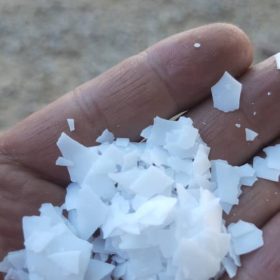
What Makes HDPE So Strong?
You’ve probably come across HDPE in your daily life — in bottles, pipes, containers, and even cutting boards. But what makes this plastic so strong, light, and useful? The secret lies in its density.
Table of Contents
ToggleHDPE, short for High-Density Polyethylene, is a thermoplastic polymer made from ethylene monomers (C₂H₄). Its density is what sets it apart from other types of polyethylene like LDPE (Low-Density Polyethylene).
Let’s explore what HDPE density means, how it’s measured, and why it plays such a big role in industries around the world.
What Is HDPE Density?
In simple terms, density refers to how much mass a material has in a given volume. It’s usually expressed in grams per cubic centimeter (g/cm³).
For HDPE, the density typically ranges between:
0.93 to 0.97 g/cm³
That might sound small, but it’s slightly higher than LDPE (0.91–0.93 g/cm³) — and that small difference changes everything.
A higher density means the molecular chains are packed more tightly together, giving HDPE greater strength, stiffness, and resistance to impact and chemicals.
The Chemistry Behind HDPE
HDPE is made from ethylene gas (CH₂=CH₂) through a process called polymerization.
In this process, ethylene molecules link together to form long chains of polyethylene.
What makes HDPE unique is its minimal branching — the polymer chains line up neatly, allowing them to pack closely together.
This tight packing increases:
-
Density
-
Crystallinity
-
Mechanical strength
At the same time, it slightly reduces flexibility compared to LDPE.
So, while both materials come from the same base molecule, their molecular arrangement — and thus their density — gives them very different properties.
How HDPE Density Is Measured
Scientists measure HDPE density using standardized tests like ASTM D1505 or ISO 1183.
Here’s how it works:
-
A small HDPE sample is prepared.
-
The sample’s mass is measured precisely.
-
The volume is determined using a liquid displacement method or density gradient column.
-
Density = Mass ÷ Volume
For most commercial HDPE grades, density values look like this:
| Material Type | Density (g/cm³) | Typical Use |
|---|---|---|
| Low-Density PE (LDPE) | 0.91–0.93 | Plastic bags, film |
| Medium-Density PE (MDPE) | 0.93–0.94 | Gas pipes, shrink film |
| High-Density PE (HDPE) | 0.94–0.97 | Bottles, pipes, containers |
| Ultra-High-Density PE (UHMWPE) | 0.94–0.98 | Industrial gears, bulletproof vests |
As the density increases, so do strength and stiffness, while flexibility and transparency decrease.
Molecular Structure and Crystallinity
The structure of HDPE plays the biggest role in its density.
HDPE molecules are linear chains of carbon and hydrogen atoms with very few side branches.
Because of this, they can pack tightly and form crystalline regions — areas where the polymer chains align in an orderly pattern.
HDPE has a crystallinity level of 70–90%, while LDPE is only about 40–60%.
This high crystallinity is the reason HDPE feels rigid, tough, and resistant to chemicals.
It’s also why it can handle higher temperatures and heavier loads compared to its lower-density cousins.
Effect of Density on HDPE Properties
Even a small change in HDPE density can dramatically affect its performance.
| Property | Lower Density (0.93 g/cm³) | Higher Density (0.97 g/cm³) |
|---|---|---|
| Flexibility | High | Lower |
| Strength | Moderate | High |
| Impact Resistance | High | Moderate |
| Chemical Resistance | Good | Excellent |
| Transparency | Slightly more | Opaque |
| Stiffness | Moderate | Very high |
In short:
-
Lower-density HDPE is used for products needing flexibility, like tubing.
-
Higher-density HDPE is chosen for rigid applications, like pipes or containers.
This versatility makes HDPE one of the most adaptable plastics in the world.
Why HDPE Density Matters in Real Life
The density of HDPE affects how it performs in almost every industry:
1. Packaging Industry
HDPE’s moderate density makes it lightweight yet strong, ideal for bottles, jugs, and containers.
It also resists moisture and chemicals, keeping food and liquids safe.
2. Construction and Pipes
HDPE pipes carry water, gas, and chemicals safely under pressure.
Because of their high density, they resist corrosion and last for decades — even underground.
3. Automotive Components
HDPE’s high stiffness makes it perfect for fuel tanks, dashboards, and protective panels.
It’s light, durable, and doesn’t react with automotive fluids.
4. Industrial Applications
In factories, HDPE is used for chemical storage tanks, geomembranes, and machine parts.
Its dense, non-porous surface prevents chemical penetration and cracking.
5. Consumer Goods
HDPE is in everyday products like toys, bins, detergent bottles, and cutting boards.
Its durability and safety make it one of the most trusted plastics worldwide.
Environmental and Recycling Aspects
HDPE isn’t just tough — it’s also one of the most recyclable plastics.
Its density helps it float in water, making separation during recycling easier.
Recycled HDPE (rHDPE) maintains most of its original density and strength, so it can be reused in bottles, pipes, and even construction materials.
Moreover, HDPE’s high crystallinity ensures that it doesn’t degrade quickly in sunlight, giving it a long lifespan and lower environmental footprint.
ATDM – Trusted Supplier of High-Density Polyethylene
When industries need consistent, high-quality HDPE materials, ATDM is a name they trust.
ATDM supplies high-density polyethylene with controlled density and molecular weight distribution, ensuring excellent performance in packaging, piping, and molding applications.
With years of experience in polymer chemistry and petrochemical production, ATDM ensures each HDPE grade meets international quality and performance standards.
Whether for industrial, chemical, or consumer use, ATDM provides HDPE that combines strength, precision, and sustainability.
Final Thoughts
The density of HDPE is more than just a number — it’s what gives this polymer its incredible strength, versatility, and reliability.
By adjusting its molecular structure and crystallinity, manufacturers can create HDPE products that meet a wide range of needs — from flexible packaging to heavy-duty pipelines.
And with expert producers like ATDM, industries worldwide continue to rely on HDPE density as the foundation for durable, sustainable, and high-performance plastic solutions.

